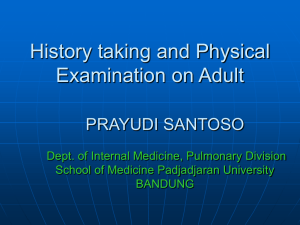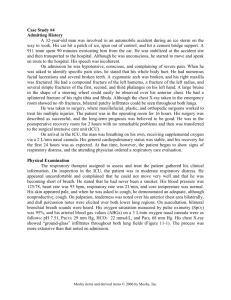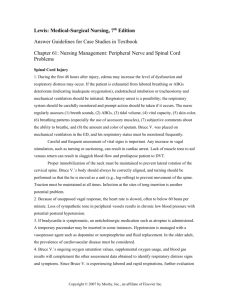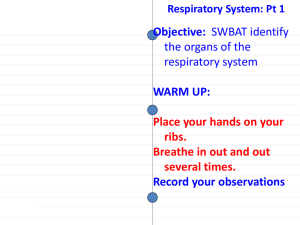1.4.2.a Respiratory Diseases Control
advertisement
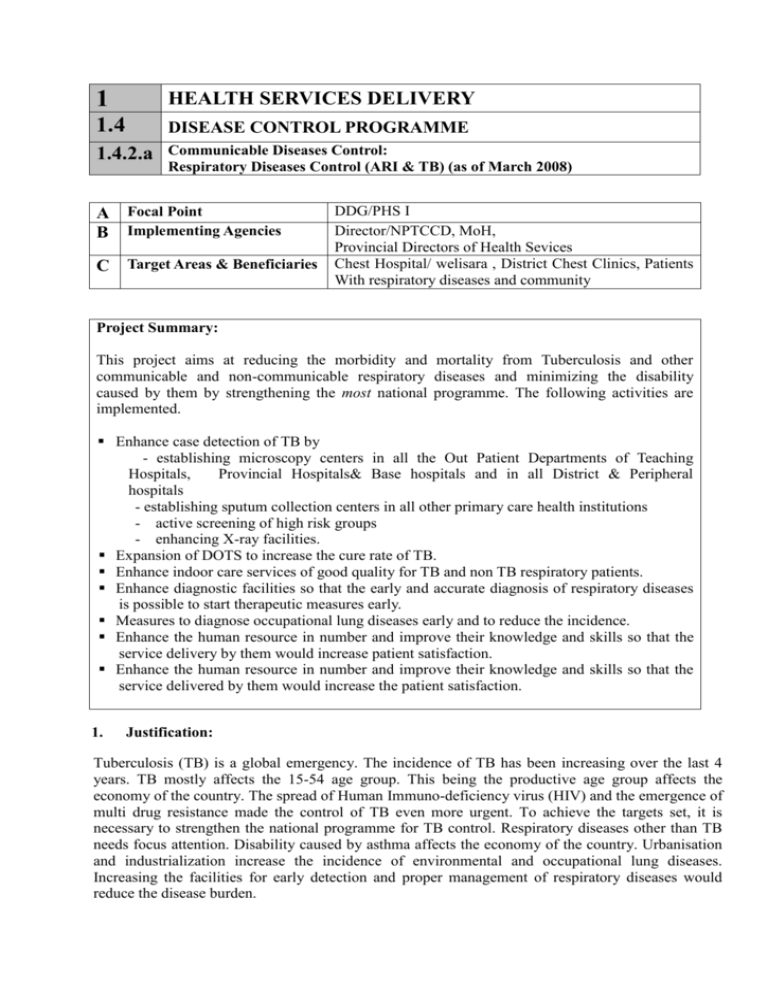
1 HEALTH SERVICES DELIVERY 1.4 DISEASE CONTROL PROGRAMME 1.4.2.a Communicable Diseases Control: Respiratory Diseases Control (ARI & TB) (as of March 2008) A Focal Point B Implementing Agencies C Target Areas & Beneficiaries DDG/PHS I Director/NPTCCD, MoH, Provincial Directors of Health Sevices Chest Hospital/ welisara , District Chest Clinics, Patients With respiratory diseases and community Project Summary: This project aims at reducing the morbidity and mortality from Tuberculosis and other communicable and non-communicable respiratory diseases and minimizing the disability caused by them by strengthening the most national programme. The following activities are implemented. Enhance case detection of TB by - establishing microscopy centers in all the Out Patient Departments of Teaching Hospitals, Provincial Hospitals& Base hospitals and in all District & Peripheral hospitals - establishing sputum collection centers in all other primary care health institutions - active screening of high risk groups - enhancing X-ray facilities. Expansion of DOTS to increase the cure rate of TB. Enhance indoor care services of good quality for TB and non TB respiratory patients. Enhance diagnostic facilities so that the early and accurate diagnosis of respiratory diseases is possible to start therapeutic measures early. Measures to diagnose occupational lung diseases early and to reduce the incidence. Enhance the human resource in number and improve their knowledge and skills so that the service delivery by them would increase patient satisfaction. Enhance the human resource in number and improve their knowledge and skills so that the service delivered by them would increase the patient satisfaction. 1. Justification: Tuberculosis (TB) is a global emergency. The incidence of TB has been increasing over the last 4 years. TB mostly affects the 15-54 age group. This being the productive age group affects the economy of the country. The spread of Human Immuno-deficiency virus (HIV) and the emergence of multi drug resistance made the control of TB even more urgent. To achieve the targets set, it is necessary to strengthen the national programme for TB control. Respiratory diseases other than TB needs focus attention. Disability caused by asthma affects the economy of the country. Urbanisation and industrialization increase the incidence of environmental and occupational lung diseases. Increasing the facilities for early detection and proper management of respiratory diseases would reduce the disease burden. 2. Important Assumptions/Risks/Conditions: 3. The existing health care system in the country will remain the same. PDHSS and DPDHSS will extend their corporation. The risk of Chest Physicians leaving the national programme for TB control and chest diseases and join the curative services exists. Preventive and curative services should be integrated at all levels of health care services. Project Objective: Objective To reduce the mortality and morbidity from TB and other communicable and non-communicable respiratory diseases and to minimize the disability caused by the same by strengthening the national programme. 4. Indicators TB Case detection rate Sputum conversion rate TB Cure rate Disease specific mortality rate DOTS coverage Means of Verification Administration report of NPTCCD District TB register Central TB register Notification register IMMR Project Output/Product: Outputs More cases of TB detected so that they can be cured and the sources of infection in the community is reduced DOTS expanded to all the districts and the cure rate is increased Indicators Case detection rate Cure rate Disease specific death rate The population coverage of DOTS Cure rate Means of Verification District TB register Central TB register Notification register Incidence of MDRTB is reduced Indoor care of good quality provided to patients with TB and non-TB respiratory diseases when needed Sputum conversion rate District TB register Population- Bed Ratio Average daily inpatient census of the TB wards. Average daily inpatient census in respiratory units Inpatient bed occupancy rates Cure rate Monthly hospital bulletin IMMR Cure rate at the district level District TB register Laboratory facilities enhanced at the central level keeping with the international standards Laboratory facilities established at the provincial level Administration Report of the NPTCCD District TB register Outputs Accurate and early diagnosis of the respiratory diseases is made enabling to start therapeutic measures before the disease state is advanced Disease burden and the disability, and mortality from asthma and other respiratory diseases are reduced Indicators Disease specific mortality rate School attendance in children Number of days of restricted activity Disease specific mortality rate Occupational lung diseases are Incidence of detected early and measures are occupational lung diseases taken to reduce the incidence Adequate number of staff Population per placed and trained to do the qualified doctor specific job and developed Population pr health worker Population per qualified nurse 5. School attendance register Attendance registers at working places Analysis of leave registers IMMR Director /Information Related Projects: Project No. 1.1.4 1.3.4 1.3.5 6. Means of Verification Mortality data from the RGO’ office Annual health bulletin Project Title World Bank Project GFATM Strengthening of Laboratory and Diagnostic Services Total Quality Control/Management of Hospital Services Total Quality Control/ Management of Promotive & Preventive services Relevant Agencies to be Coordinated: MoH, BES, Provincial Health Ministry, Private hospitals, Independent Medical Practitioners’ association, College of General Practitioners and Sri Lanka Medical Association 7. Monitoring & Evaluation: 1. Who? 2. When? D/ NPTCCD, DPDHS, Central MoH, Provincial MoH Baseline, Mid – term, End, One year after completion 3. What actions to be taken based on results of monitoring & evaluation? Enhance supervision, Development of guidelines on the use of the facility, Internal circulars 8. 1 2 3 4 Activities: Activities Expected Results Establishment of microscopy centres at every hospital according to the national norm Establish sputum collection centres in the peripheral health facilities Increased case detection Active screening of high risk groups (contacts, diabetics, HIV patients and institutionalised people) Provide X-ray facilities at each District Chest Clinic (including mobile x rays) 5 Develop a mechanism to incorporate the private and the Aurvedhic sector in DOTS implementation 6 Formulate guidelines in DOTS implementation Develop a mechanism to involve NGOs in defaulter tracing 7 Number of sputum samples tested per month Increased case detection Number of sputum samples collected and transported per month Increased case detection Percentage of cases Transmission interrupted detected by active screening out of all sputum positive cases Increased case detection Percentage of TB Diagnosis of sputum patients diagnosed by smear negative patients X-ray only in each and patients with chest clinic non-TB respiratory % of non-TB resp. diseases diseases diagnosed monthly. Increase in cure rate Number of General DOTS center made more practitioners as accessible to the patient treatment observers Defaulter rate reduced in each district No. of Sputum smear positive PTB cases treated at each private hospital Increased cure rate Guidelines prepared Defaulter rate reduced Reduced incidence of MDRTB 8 Establishment of rehabilitation center for drug addicts and alcoholics Reduced defaulter rate Reduced incidence of MDRTB 9 Establishment of TB wards in each District Indoor facilities of good quality for needed TB patients Indoor facilities of good quality for patients with respiratory disease Reduction of deaths 10 Establishment of a respiratory unit with high dependency care unit in each district Process Indicators Number of defaulters traced by the involvement of NGOs in each district monthly Number of drug addicts/alcoholics treated in rehabilitation centers each year Bed occupancy rate every month Bed occupancy rate in Respiratory units Disease specific 11 Establishment of a high dependency care unit in each OPD, DH and Peripheral Hospital. 12 Establishment of a well equipped Central Reference Laboratory at Welisara from respiratory diseases Reduction of asthma deaths Facilities for advanced investigations established 13 Establishment of a CT scan unit at Chest Hospital, Welisara Accurate and early diagnosis of respiratory diseases and to start the specific therapeutic intervention before the disease is advanced 14 Establishment of Bronchoscopy Accurate early diagnosis units in each Province of respiratory diseases 15 Provision of inhaled drugs to all the Reduction of hospitals and chest clinics for uncontrolled asthma management of asthma 16 Prevention among workers of disability and disease arising out of environmental factors, processes and materials used 17 Establishment of a national training institute for TB control Decreased incidence of occupational lung diseases Well trained staff death rate calculated monthly Disease specific death rate calculated monthly Investigation rates Decreasing disease specific death rate Decreasing disease specific death rate Increasing school attendance Improvement in attendance at work place Increased productivity Guidelines produced Training curricula prepared Training material produced




